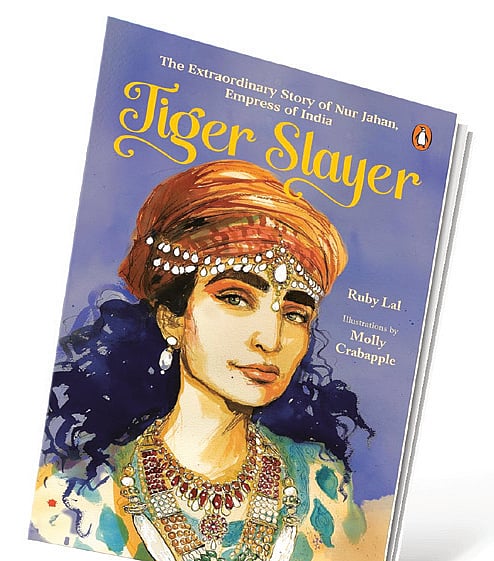The Empress Mystique

In an extraordinary and surely not absent-minded sleight of hand, a fascinating Mughal queen has just been erased from the new Class VII schoolbooks in India—Nur Jahan. It is therefore wonderfully felicitous that historian Ruby Lal has this very same year published a young-adult biography of this sometimes controversial but always beguiling woman.
In Tiger Slayer: The Extraordinary Story of Nur Jahan, Empress of India, Lal begins the story of Nur Jahan with the arrival of her parents in Hindustan—elite migrants leaving Persia to seek employment at the wealthy and inclusive court of Mughal emperor Akbar. This allows Lal to describe life in the fascinating Mughal cities of Fatehpur Sikri and Agra, as the young Nur Jahan grows up in the care of her parents, giving the reader an insight into the daily lives of the people at these courts; the foods they ate, the activities they took part in, the ateliers that thrived at the court and a great deal more. Certain insights are truly astonishing; elite women, Lal tells us, used the rooftops of houses to travel through the city unseen. Lal is especially meticulous in describing the dynamic space of the harem within which the women lived their capacious, busy lives, brimming with the noisy presence of foster mothers, nurses, companions, attendants, extended family and more. This harem is far from the outdated notion of a claustrophobic, ossified space. “In practice,” specifies Lal, “even from behind the walls women lived brilliant and daring lives.”
The book then follows the life of Nur Jahan as she stepped into her destiny when she became emperor Jahangir’s 20th wife. With Jahangir growing older and increasingly unwell, Nur Jahan used her talent and ambition to govern alongside him, becoming ‘visible’ in a way that no other Mughal woman ever was. She minted coins in her name, passed orders, and indulged in that most imperial of prerogatives—tiger hunting.
After Shah Jahan finally became the 5th Mughal emperor following a prolonged and bloody war against his brothers and their allies, including Nur Jahan, he would go to great lengths to erase the memory of the woman who he believed had turned his father against him. He recalled the coins minted in her name, and his chroniclers were careful to scuff her name from their records. Nur Jahan herself was exiled to Lahore and many of her courtiers were dismissed. Later colonial writers, always leery of a woman’s ‘visibility’ at court and her extraordinary power, wrote of her in disparaging terms, accusing her of being overly ambitious and seeking to manipulate and control her husband the emperor. Nur Jahan’s legacy, therefore, was always in danger of being forgotten.
2026 New Year Issue
Essays by Shashi Tharoor, Sumana Roy, Ram Madhav, Swapan Dasgupta, Carlo Pizzati, Manjari Chaturvedi, TCA Raghavan, Vinita Dawra Nangia, Rami Niranjan Desai, Shylashri Shankar, Roderick Matthews, Suvir Saran
The effortless ease with which Lal is able to recreate the world of Nur Jahan is not simply fortuitous. A self-professed feminist historian, Ruby Lal and has directed the blaze of her intelligence, her academic rigor and her passion, into researching and re-assessing the influence of these Mughal women. From her seminal debut work on the influence of the elite women of the early Mughal world to her biographies on Nur Jahan and Gulbadan Begum—Akbar’s aunt—Ruby Lal has been waging a relentless war against the erasure of the legacies of these formidable women.
In a manner echoing the fabled manuscripts of the Mughal court, Tiger Slayer too is illustrated. Molly Crabapple, an award-winning political artist, journalist and writer based in New York, has wrought a bewitching alchemy to bring the lives of the Mughals to glorious life. When trying to recreate the sumptuous world of the Mughals with their glittering jewels, swirling fabrics and restless animals, it can sometimes feel like words are not enough. Through Crabapple’s gorgeously vibrant paintings, this elusive world is brought alive once more. At a time when Mughal history itself is under assault, Ruby Lal brings the fascinating story of Nur Jahan to a new generation of readers.

